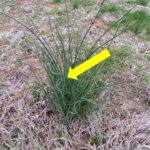Biology: Wild Garlic (Allium vineale) is a monocotyledonous cool-season perennial that can be found throughout most of the eastern and southern United States. Despite having linear leaves and parallel veins, wild garlic is neither a grass nor a sedge; it is a member of the lily family. Wild garlic is more noticeable in the winter and early spring months when the turf is not actively growing or being mown. Plants reproduce from seeds and aerial bulbets from early spring and throughout the summer months. Its ability to tolerate a wide range of soil types, and to survive mowing height typical of lawns make wild garlic a difficult-to-control weed.
Identification: Wild garlic is a bulbous perennial with grass-like leaves that emerges in the early spring. Leaves are slender, rounded, and hollow. Wild garlic is often mistaken for wild onion; however, wild onion leaves are more flattened and are not hollow. Wild garlic leaves have a distinct garlic-like odor when crushed or mown. Leaves emerge from an underground white bulb with a papery outer coating, which also gives rise to multiple bulbets that are flattened on one side and also covered by a papery-like membrane. Greenish-white ‘flowers’ can be observed atop short flowering stems in late spring through early summer. In the place of flowers, small globe-shaped aerial bulbets are produced that are greenish-white and have long tail-like green leaves. Wild garlic plants may die back in the summer, but leafless stalks bearing viable seed capsules may remain.
Cultural control: Hand-pulling wild garlic is generally not an effective method of weed control since hollow stems are easily broken leaving the bulb below the soil to generate new leaves and new bulbets. As a result, bulbs need to be dug-up in order to achieve an adequate level of control. The most common infestation in a landscape is when new soil is brought in to the site that contains the bulbets. Inspect soil brought from off-site to ensure it is free of wild garlic and nutsedge.
Biological control: None known for specific use in wild garlic.
Chemical control: There are not any effective preemergence herbicides labelled for wild garlic, so postemergence herbicides will be the only chemical control strategy. In landscapes and nurseries there are four labelled postemergence herbicides, which include bentazon, sulfosulfuron, sulfentrazone, and imazaquin. These products will control wild garlic, as well as other difficult to control weeds. Directed sprays in landscapes are recommended to prevent phytotoxic effects on ornamentals. In cool-season turf, wild garlic is difficult to control. There are no preemergence herbicide options for wild garlic in cool-season turf; however, there are a few postemergence herbicide options. Applications of 2,4-D alone or in multiple combinations with MCPP and dicamba (Trimec, Triplet, etc.) may achieve fair levels of control. The ester formulations of 2,4-D are more effective against wild garlic than the amine formulations (consult the Purdue Turfgrass Weed Control for Professionals extension publication (link below) for more information regarding the differences between amine and ester 2,4-D formulations). Additionally, mowing the weeded area prior to application may improve herbicide uptake and overall control of wild garlic in cool-season turf.

